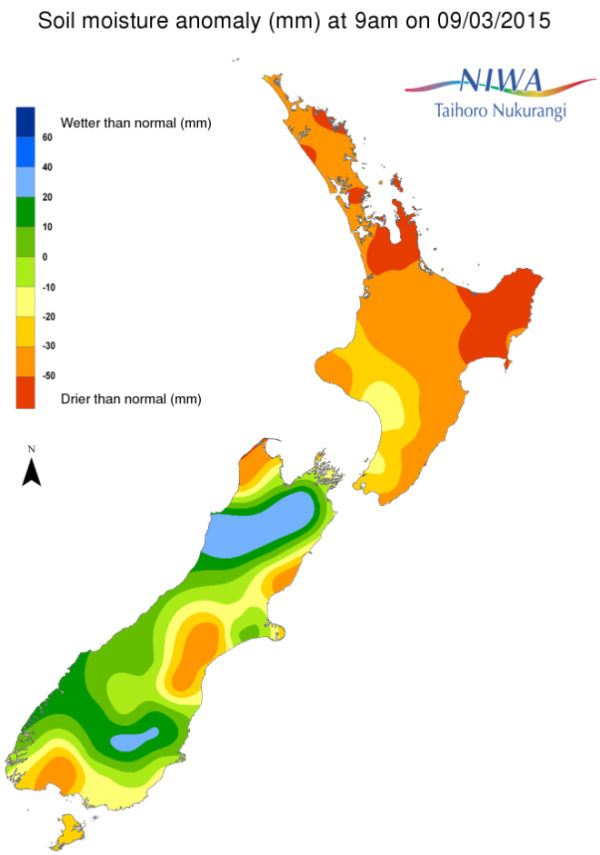Weekly update to help media assess likelihood of extremely dry weather preceding a drought. Regions experiencing severely to extremely drier than normal soils conditions are deemed “hotspots”.
Facts: Soil moisture
For the North Island, soil moisture levels are much drier than normal for this time of year for the majority of the island. Severely to extremely drier than normal soil moisture persist in much of the northern and eastern portions of the island. This includes parts of the Bay of Plenty, Wairarapa, eastern Manawatu-Wanganui and southern Taranaki regions as well as much of Hawke’s Bay, Gisborne, Auckland and Northland regions.
For the South Island, soil moisture levels remain drier than normal for this time of year for large sections of the eastern, northwestern and southwestern parts of the island. Severely to extremely drier than normal soils for this time of the year exist in parts of eastern Canterbury as well as pockets of western Southland. Wetter than normal soils for this time of year are present for coastal areas of the northern West Coast region.
Week-to-week comparison
For the North Island, when compared to this time last week, the coverage and severity of drier than normal soils has decreased over the western and southern part of the island. However for all remaining portions of the island, the size of severely to extremely drier than normal soils for this time of year has remained the same, if not grown slightly over the Waikato, Gisborne and Hawke’s bay regions as well as pockets of the Auckland and Northland regions.
For the South Island, there has been a significant increase in soil moisture content over much of the island, especially over the northern half of the island. However, there still remains severely to extremely drier than normal soils for this time of year for areas over parts of eastern Canterbury from roughly Ashburton to north of Oamaru as well as between Banks Peninsula to south of Kaikoura. Isolated hotspot pockets also exist over central and western parts of Southland, west and northwest of Invercargill.
Commentary
For the North Island, when considering the current soil moisture anomalies for this time of year, hot- spots exist in much of the Auckland, Waikato, Gisborne, parts of the Northland, Bay of Plenty, southern Taranaki, eastern Wellington and eastern Manawatu-Wanganui regions. Overall, the driest soils relative to this time of year are present over northern and eastern Waikato as well as eastern Bay of Plenty, Gisborne and northern Hawke’s Bay regions.
For the South Island, hotspot areas persist in sections of eastern Canterbury as well as isolated pockets of southern and western Southland. Overall, the driest soils relative to this time of year are present over the hotspot areas of eastern Canterbury.
For hotspot regions, sustained rainfall over an extended period of time is needed to return conditions back to normal.
Background
Hotspot Watch is a weekly advisory service for New Zealand media. It provides soil moisture and precipitation measurements around the country to help assess whether extremely dry conditions are imminent.
Soil moisture deficit: the amount of water needed to bring the soil moisture content back to field capacity, which is the maximum amount of water the soil can hold.
Soil moisture anomaly: the difference between the historical normal soil moisture deficit (or surplus) for a given time of year and actual soil moisture deficits.
Definitions: “Extremely” and “severely” dry soils are based on a combination of the current soil moisture status and the difference from normal soil moisture.
View NIWA's soil moisture maps
Soil moisture anomaly maps
The following maps show soil moisture relative to this time of year. The first map shows the values this time last week. The second map below shows the most recent values.


